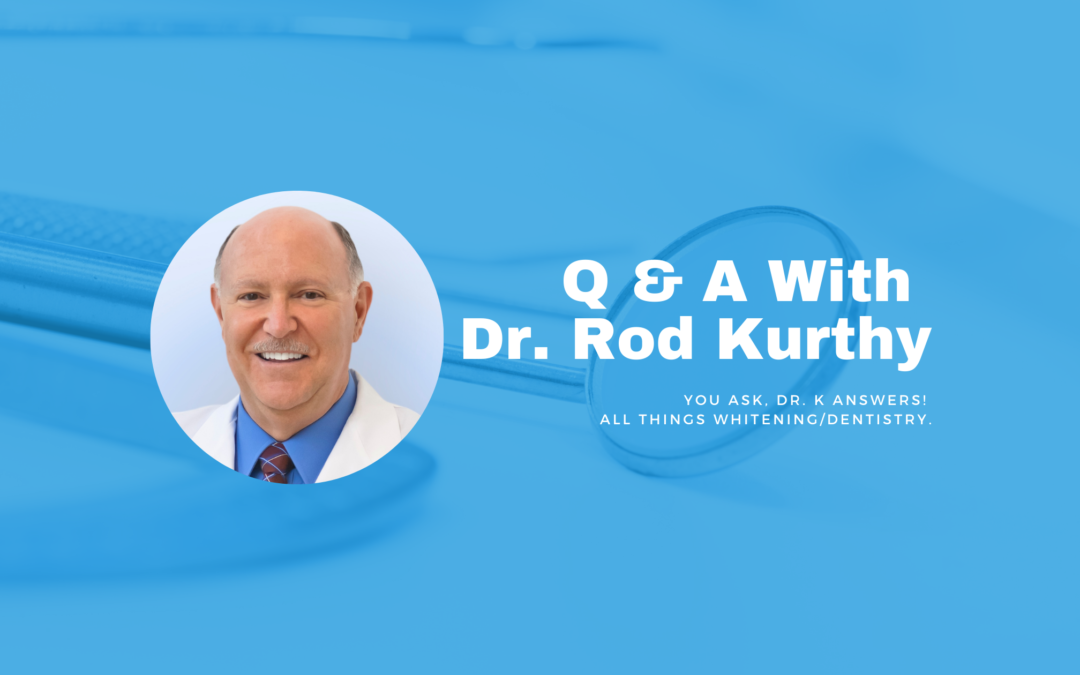Dr. Andrew asked, “Why don’t you use a light or laser with the in-office treatment?”
Hi Andrew. Thank you for the question.
There’s a simple answer to this, which is, “Lights and lasers provide no genuine long-term whitening effectiveness AND they are damaging to the pulp.”
If my above answer is correct, the question then becomes, “Why, supposedly, do some companies recommend lights or lasers?” In my opinion, it’s for marketing and sales – period.
So let’s dig down into the weeds just a little:
Lights and lasers provide no additional effectiveness
What do lights and lasers (photon energy) supposedly do to enhance the results of whitening? “Supposedly,” they enhance the breakdown of hydrogen peroxide. And if the breakdown reaction of hydrogen peroxide was an endothermic reaction (which it’s not), then yes, possibly lights and lasers or heat energy might speed up the breakdown reaction a tiny bit.
Just like back in high school and college chemistry lab. You mix a couple of ingredients (reactants) into a bowl and find that nothing happens. So you put the bowl over a Bunsen burner to add heat energy, and BAM!, the reaction proceeds.
Endothermic reactions require energy to be added to the chemical reaction, or at least the ability to absorb surrounding energy (such as absorbing surrounding ambient heat) for the reaction to proceed. So that would make sense using the lights or lasers to add photon energy to the breakdown endothermic reaction.
But the simple fact is, the breakdown of hydrogen peroxide to products (bleaching factors) such as perhydroxyl radicals, hydroxyl radicals, superoxide radicals, oxygen ions and hydrogen ions is an exothermic reaction.
An exothermic reaction needs to get rid of energy for the reaction to proceed. Think about when you mix stone or plaster. As it sets, it gives off energy (heat), and the models become quite warm.
According to Le Chatelier’s Principle of Chemical Equilibrium, if you try to force energy back into an exothermic reaction (which is trying to get rid of energy), you could even impede the speed of the reaction. Regardless, trying to add photon or any other type of energy to an exothermic reaction certainly will not help.
There are definitely several scientific studies that show the use of lights and lasers does work. However, if you look at those studies, the vast majority of them have been funded by the companies that make the lights and lasers. The very strong majority of all scientific studies (far more than studies funded by light/laser companies) show virtually no whitening benefit from the use of lights or lasers.
Again, lights and lasers are claimed (by the manufacturers) to speed up the reaction’s breakdown. So, what other ways could we conceivably speed up the reaction? Chemical accelerators. Not only can we fully control the breakdown with chemical accelerators, but we can also influence what the hydrogen peroxide breaks down to – such as breaking down to the radicals instead of breaking down to oxygen and water.
The main breakdown product (bleaching factor) that causes whitening is perhydroxyl radicals. Oxygen and water do absolutely nothing to whiten teeth.
I could add a chemical accelerator to make the breakdown so fast that it would virtually explode. I can control the breakdown speed to whatever I want using chemical accelerators. So why would I even need to consider lights or lasers?
Also, consider this – if lights and lasers are supposedly so effective at speeding up the breakdown of peroxide, why does every whitening gel intended to be used with lights or lasers also contain chemical accelerators? It makes you think…
So again, in my strong opinion, lights and lasers provide “flair” to the procedure, and nothing more (other than additional discomfort).
Lights and lasers create pulpal inflammation and pain
Most dentists have found that lights and lasers increase the immediate and/or delayed pulpal pain from in-office whitening. So why is that?
Well, most will tell you that bleaching lights and lasers cause pain due to: 1) Dehydration of the teeth caused by the light or laser, and/or 2) The heat lights and lasers generate on the teeth. Both of these claims are nothing more than urban legends. Neither is true.
Studies have been done, including my own study, that found the following:
- Lights and lasers alone caused zero sensitivity.
- High concentration hydrogen peroxide gel alone resulted in zero to mild sensitivity.
- The combination of lights and lasers with high concentration hydrogen peroxide whitening gels resulted in mild to severe pain.
The cause is the result of the combination of whitening gel and lights/lasers. The reason for this was found to be the pulpal release of Substance P when high concentration peroxide is used along with photon energy. Substance P is a neuropeptide acting as a neurotransmitter/neuromodulator. When the neurons release Substance P, the Substance P triggers the next neuron to fire.
Substance P has one, and only one, function in the pulp – to cause pulpal inflammation and pain. The only possible good news here is that it is nearly always transient, and goes away after some period of time.
So the main question to dental practitioners is, why would you ever use a technology on your patient that provides no benefit, yet causes pain – and frequently severe pain?
Very best regards,

Dr. Rod Kurthy


